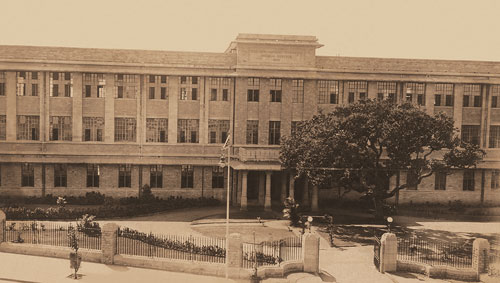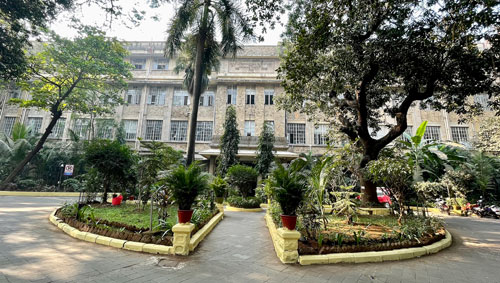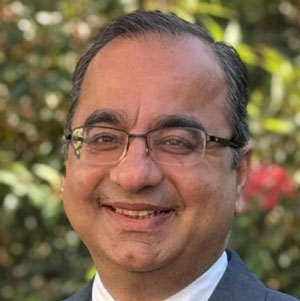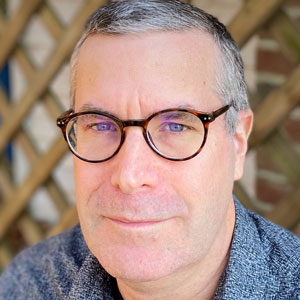The GOSUMEC Foundation proves that you don’t need to be a big nonprofit to achieve sizable results.
Editor’s note: Looking for the second half of our GIVING cover feature? Click here.
When Dr. Sanjay Bindra and his wife, Dr. Archana Bindra, celebrated their 25th wedding anniversary in 2023, they did things a little differently than most couples.
It started with a simple plan: give back to the medical school in India where they met. The San Francisco Bay Area couple—both busy physicians—initially intended to gift $150,000 to a one-time project benefitting the Seth Gordhandas Sunderdas Medical College (GOSUMEC) in Mumbai, India.
But after a few phone calls, that simple plan grew into something a lot more ambitious.
The Bindras were looking to create a gift with long-term impact; something beyond just a one-time donation. “Then I came up with the idea that we can pull in other people who are grateful like us, and we can start something meaningful, which will perpetuate … and so we said, ‘the way to do this would be to start a 501c3 nonprofit,’ ” Dr. Sanjay says.
An Uphill Battle
It’s no secret that creating a nonprofit and sustaining a nonprofit (let alone growing it) are two very different exercises. And when you’re a busy cardiac electrophysiologist with a full-time clinical practice to run, it sounds like a recipe for—at best—mediocrity.
The National Center on Charitable Statistics tells us a whopping 30 percent of nonprofits disappear after just 10 years. Industry insiders know many either fail even more quickly; circle for years in a starvation cycle; or simply languish into irrelevance.
But you don’t endure the grueling requirements of medical school, residency, and board certification if you’re afraid of hard work and a challenge. Dr. Sanjay dug in and started researching fundraising options, while simultaneously networking to build a GOSUMEC alumni database.
“I think there are about a thousand of us in the United States, spanning over five decades,” he says. “Typically, 10% of our class comes to the United States, so we said, ‘first, we need to link with these people.’ ”
Connecting with former students, however, turned out to be the biggest challenge. “We didn’t have an alumni association, so I didn’t know all of these people,” he says.
Dr. Sanjay turned to social media, and also relied on word of mouth to perpetuate the cycle. “When somebody becomes a donor, he connects me.”
“It was a lot of work, in 2023, getting people together,” he says. “Having the buy-in from people, and the social proof of people coming on, helped.”
And his engagement efforts have grown by leaps and bounds from those strictly virtual days. “We’ve had small reunions all across the country,” he says. “Last year we had six of them: Southern California, Northern California, Chicago, Hoboken, Minneapolis and Houston.”
Strategic Planning
The nonprofit focuses on scholarships for maximum impact. “At the outset, I said that we need to have the legacy model,” Dr. Sanjay says. “My father-in-law was emeritus professor of history at UCLA, and he was chairman of the education abroad program. He was involved in the resurrection of the Asiatic Society Library in India.”
Many of the library’s manuscripts—which were in tatters—date back to the pre-18th Century, “with the earliest recorded from the 1500s.”
Using a legacy giving model, his father-in-law was able to raise 10 times the amount requested for their restoration and preservation, he says.
“With that in the back of my mind, that’s how we started,” Dr. Sanjay says.
Next came the question of a platform. The couple decided to cover startup costs, so affordability was a factor.
“We said at the outset that we will be a zero-staff organization. I’ve done 99 percent of the work, and my wife has done 99 percent of the advising to me,” Dr. Sanjay says. “Our biggest expense is the passion and the drive to run all of this.”
After much research, they settled on Givebutter. The all-inclusive platform acts as a hub for GOSUMEC’s donor engagement, gift tracking, and more. “It’s exceptional,” he says.
Transparency is paramount. All statements are on their website, and they’ve already achieved GuideStar platinum status. “Next year we’ll have a four-star rating with Charity Navigator as well,” he says.
Healthy Prognosis
All that hard work has paid off, and then some.
By the end of 2024, the GOSUMEC Foundation USA’s assets stood at $1,052,088.
“In the first year … we got almost 400 percent of what we had planned to collect,” he says.
That’s when Dr. Sanjay started researching legacy giving.
But much of what he read or heard was disheartening for an organization barely out of its infancy—planned giving is a waiting game, and more complex gifts such as QCDs, CGAs, and the like can be difficult for a smaller organization to facilitate.
“I was told we were ‘too young’ to talk about legacy giving. But we knew that legacy isn’t just about age or wealth; it’s about values and belief in a mission that should outlive us,” he says.
Inspired in part by PlannedGiving.Com CEO Viken Mikalian’s LinkedIn posts, Dr. Sanjay kept digging. And that’s when he found the solution: a scholarship model. Gifts to the foundation fund Legacy and Mini Legacy scholarships that directly assist students in India.
“Our scholarships are need- and merit-based … these are pay-it-forward scholarships, so this is not financial aid,” he says. “There is an expectation, a non-covenant agreement; not enforceable; it’s a pledge by the scholar that when they are financially able, they’ll pay it forward.”
That covenant, in turn, is tracked by the largest nonprofit in India, the Foundation for Excellence. Based in the Bay Area, it’s the largest sponsor of engineering and medical students in India, Dr. Sanjay says.
What’s more, the GOSUMEC Foundation has created a perpetual endowment—the first of its kind for Indian medial schools.
“We structured it so that a legacy scholarship will support one new student every year into perpetuity,” he says. “Fully funded, it will support five students every year at different stages in their school career into perpetuity.
“Our individual scholarship fund is held in cash equivalents for immediate disbursement,” he says. “We maintain zero overhead, with 100 percent of these funds disbursed directly to scholarships in India, thanks to a separate operational fund—the Ember Circle. Legacy Funds (Legacy Corpus and Community Corpus) are invested in a 70/30 allocation—70 percent in S&P 500 index funds and 30 percent in U.S. Treasuries.”
The Foundation also accepts a wide range of planned gifts, from QCDs to gifts of real estate and more.
So, what’s Dr. Sanjay’s prescription for success at scale?
“A small nonprofit has the view of a small nonprofit. It has the resource constraint of a small nonprofit, and it needs to approach the entire literature of giving—the entire psychology behind giving—like a small nonprofit,” he says.
“Now we need to study this moving forward, and break the myth that bigger is better. Small and mighty,” he says.
To learn more about the GOSUMEC Foundation, visit Gosumec.org.
Editor’s note: All this work in philanthropy has had an interesting side effect on Dr. Sanjay: He’s become a champion of small nonprofits. Read the rest of this story below and learn more about his landmark Give Study.


Part 2
Scale Model
Being new to the fundraising world, Dr. Sanjay Bindra was determined to learn as much as he could as quickly as he could. “I read a lot, so I became a student of nonprofits,” he says.
And what he learned came as a surprise.
“My research showed that what is in the literature pertains to medium and large nonprofits,” he says. “They have development staff; they have fundraising teams … that is not something a small nonprofit can do. And the other thing I learned is that the nonprofit communications model is borrowed from the for-profit communications model.”
And that, as he points out, is neither sustainable nor advisable for a small organization.
“It doesn’t make sense,” he says. “Nonprofit experts talk about over-communicating … but I don’t see a community of 250 people, of which 100 are donors, wanting to be bombarded with messages.”
The answer, of course, is to scale down—which is exactly what the foundation did.
“Two emails a month is enough because you already have a supportive community,” he says. The first is called Friendly Friday, and relies on subjective stories. The second, called Mid-monthly Pulse, shares metrics—financials, student data, and links to transparency documentation.
They also send up to six texts per year, and—naturally—rely on personal phone calls to maintain relationships.
By next year, Dr. Sanjay says, the foundation plans to implement an A.I. platform to deliver ringless voicemails and video content.
Eye Opener
Perhaps the most surprising thing Dr. Sanjay says he learned during his research is the number of small- to medium-sized nonprofits in the United States.
While there is no standardized scale to measure nonprofit size, the National Center for Charitable Statistics breaks it into 8 categories, starting at $100k and ending with >$50M. The $1 million mark sits squarely in the middle.
And when viewed through that lens, it quickly puts things into perspective. “There are around 1.5 million nonprofits in the United States,” Dr. Sanjay says. “Sixty percent of them have revenue less than $50,000; 70 percent have revenue less than $100,000; and a staggering 92% of them have a revenue of less than $1 million. So … almost all nonprofits in the United States are small by definition.”
The revelation led to a new passion for Dr. Sanjay. “My personal passion is in the small nonprofit space,” he says. And to say he’s become immersed is an understatement.
He recently completed the “Give Study: A Prospective Study in a Zero-Staff Nonprofit”.
“It is an attempt to be the first study of small nonprofits looking at relationship-based engagement through the 4S Framework [Simplicity, Storytelling, Smart Technology, Supportive Community],” he says.
“My goal is to democratize this message so that it helps the small nonprofit … not only create a legacy model, but also show how some nonprofits should stay small. I think that we want to stay small, and be hyper-focused on what we want to achieve. Not all nonprofits need to grow in size.”
As the saying goes, the size of your heart determines the size of your impact.

Dr. Sanjay Bindra
Physician, Philanthropist, Nonprofit Innovator
Dr. Sanjay Bindra is a board-certified Cardiac Electrophysiologist with over two decades of experience diagnosing and treating complex heart rhythm disorders. He holds multiple certifications from the American Board of Internal Medicine (ABIM) in Clinical Cardiac Electrophysiology, Cardiovascular Disease, and Internal Medicine.
Beyond clinical medicine, Dr. Bindra is widely recognized for his leadership in social impact and sustainable philanthropy. He is the President, Co-Founder, and Board Chair of GOSUMEC Foundation USA, a zero-overhead 501(c)(3) nonprofit that supports need- and merit-based medical students in India. Under his leadership, the foundation established the first endowment in India for medical education, creating a perpetual pipeline of support for underserved students.
In 2025, he launched The GIVE Study, a groundbreaking 12-month, real-time study exploring how small, volunteer-run nonprofits can achieve recurring donor growth through behavioral design, trust, and technology—without paid staff or traditional fundraising expenses. The study is specifically designed to benefit the 92% of U.S. nonprofits operating under $1M.
Dr. Bindra also serves on the Board of the Foundation for Excellence (FFE), leading a national mentorship initiative for aspiring doctors from low-income backgrounds.
His work has been featured by Givebutter, MemoryFox, and the Sustainable Giving Podcast, and is gaining national attention as a replicable model for grassroots philanthropy.
Dr. Bindra is passionate about designing systems that scale generosity, center trust, and empower the next generation of changemakers.







Inspiring!
This models how a dedicated and creative philanthropist can make an outside impact!
Bravo!
I have had the privilege of meeting this wonderful gifted couple, the Drs Bindra . Their passion to serve and give back to society is exceptional. God Almighty bless them as they continue to inspire and motivate others in their sacred journey to serve Mankind. 🙏💐
Great Job
Big Thinking
For Society
Great Job
Big Thinking
For Society